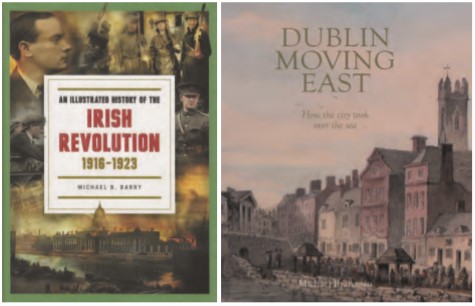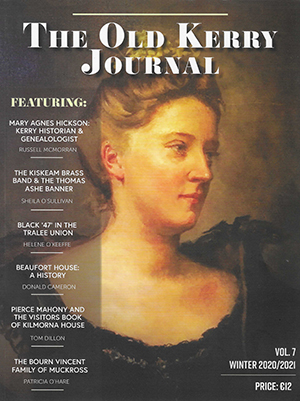BOOKWORM
Published in Book Reviews, Book Reviews, Issue 1 (January/February 2021), Reviews, Volume 29
By Joe Culley
@TheRealCulls
During the assault, he first struck his father with a hatchet. He then grabbed a flat chisel from the workbench and drove it into the man’s chest. That was the fatal blow.
It was August 1832, and John ‘Lippy’ Linn never denied that he had murdered his father, William. But the man from Smithfield in Belfast never saw the hangman’s noose; the trial judge directed the jury to find him not guilty of murder. Instead, Linn was deemed insane and sent to the Belfast Lunatic Asylum.
Just how Lippy came to such a pass, and what then became of him, is the subject of Jonathan Jeffrey Wright’s Crime and punishment in nineteenth-century Belfast: the story of John Linn, which is among the latest tranche of the popular Maynooth Studies in Local History series. Wright, himself a Maynooth lecturer, first sketched out Lippy’s tale in Salvador Ryan’s 2016 Death and the Irish and writes that this exercise in ‘microhistory’ ‘reveals the wider contexts—social, political and cultural—in which Linn’s crimes were committed and his punishment administered’.
The unfortunate Linn was born with a severe double cleft lip—hence the ‘Lippy’ moniker—and by his late teens had grown into a well-known Orange Order brawler, their ‘champion’. Wright says that Lippy could lay claim to being Belfast’s first Protestant ‘hard man’. The tale involves murder, prison breaks, sectarianism, phrenology and transportation—what more could you want?
Also in the Maynooth series, Denis Casey brings us back 700 more years to examine the specific business of Tigernán Ua Ruairc and a twelfth-century royal grant in the Book of Kells. Tigernán might be best known for the abduction of his wife, Derbforgaill, and the English invasion, but he was a successful king who ruled Bréifne (Cavan–Leitrim) for 50 years. Casey’s study looks specifically at a substantial grant of land in modern County Meath (stretching from Dulane to Slane) that Tigernán made to the church of Kells, which was originally recorded as notitiae in the margins of the Book of Kells.
Ua Ruairc may have made the grant because he had lost some power—damage limitation—or, indeed, it could have been a statement of triumph through his tactics of hyper-realpolitik: he changed sides sixteen times in the run-up to the arrival of the English. This land transfer may have been made in conjunction with the Synod of Kells in 1152, so it may be read in the context of general church reform in western Europe. Land could also be offered as a gesture of atonement or as a pious donation. For example, in the early 800s the king of Ui Maine (south Roscommon and south-east Galway) drowned the vice-abbot of Clonmacnoise (oops!), and in recompense seven churches were granted to the monastery. Overall, the study is a chance to observe how kings engaged in practical administrative matters that had political, ecclesiastical and military significance.
The other releases in the Maynooth series include Emma Lyons’s study, Morristown Lattin, County Kildare, 1630–1800: the estate and its tenants, while Brendan Scott examines the story of Belturbet, County Cavan, 1610–1714: the origins of an Ulster plantation town.

Michael Barry’s An illustrated history of the Irish revolution 1916–1923 is the fourth in his fine series on the period, having already tackled, in turn, 1916, the War of Independence and the Civil War. Full credit is due to Andalus Press for the quality of the presentation, with the more than 800—count ’em!—images beautifully reproduced. Credit, too, of course, to Barry for the enormous amount of work that went into sourcing the images and writing the story.
But what really stands out in this production is the large number of otherwise familiar images that have been colourised into vivid, near-contemporary life. Credit here goes to John O’Byrne photographers of Kildare. A couple of the colourised images that really appealed included a familiar portrait of Dick Mulcahy; a shot of the anti-Treatyites leaving the Dáil on 9 January 1922, with Cathal Brugha front and centre and smiling straight into the camera; and the less familiar image of Oscar Traynor speaking at an anti-Treaty meeting in Smithfield in Dublin that April.
Of course, one of the colourised images is that of Kevin Barry in his Belvedere College jersey (formerly assumed to be rugby but it might just as well have been hurling), which features on the cover of both Eunan O’Halpin’s Kevin Barry: an Irish rebel in life and death and Michael Moriarty’s The execution of Kevin Barry: what it said in the papers. The centenary of Barry’s death last November was extensively marked, not least by Donal Byrne’s short documentary, which, if you missed it, is worth digging out of the RTÉ archives.

O’Halpin’s easy, nuanced study of his great-uncle is as much about the world that shaped the young man as about Kevin himself. He also looks closely at the effect of Kevin’s execution on the family. For example, his elder sister Kitby became an envoy for the anti-Treaty cause and travelled to the US and Australia (at times in the company of my grandfather, J.J. O’Kelly) to spread the word. (Unfortunately, here we find the University of Notre Dame described as ‘Jesuit-run’, which will annoy both the Society and the Holy Cross fathers.)
Michael Moriarty is also related to Barry: his mother was a first cousin. He tells the later stages of the story by using the newspaper reports.
Carmel Uí Cheallaigh, a writer and librarian in Dublin, has produced Kevin Barry (Irish heroes for children), which I would estimate is aimed at students in fifth/sixth class. It’s well researched and doesn’t overdo the hagiography (though the series is called ‘Irish heroes’).
It can be difficult to imagine that much of what we consider to be Dublin city centre—say, from the Rotunda to Grand Canal docks—used to be one large flood-plain. In Dublin moving east 1708–1844: how the city took over the sea, Michael Branagan details the visionary feats of engineering that tamed the Liffey and the bay itself. It’s a fascinating story and a most handsome production, full of original sketches and maps made at the time that were previously unpublished. A beautiful work.
For the centenary of 1920’s Bloody Sunday, O’Brien Press have issued an updated edition of Michael Foley’s superb The bloodied field: Croke Park, Sunday 21 November 1920, first published in 2014. If you missed it last November, be sure to hunt down the excellent documentary by Twopair Films, which was broadcast on RTÉ (see ‘Seen on TV’, pp 54–5).
 The current volume of the handsome, magazine-format The Old Kerry Journal includes a long piece by UCC’s Helene O’Keeffe on ‘Black ’47 in the Tralee Union’, and a mini-theme touching on the stories of three of the county’s Big Houses: Beaufort House, Muckross and Kilmorna. The latter, just outside Listowel, was the home of Pierce Mahony, an Irish Parliamentary Party MP who remained loyal to Parnell after the fall and who lost his own seat in 1892 to Michael Davitt.
The current volume of the handsome, magazine-format The Old Kerry Journal includes a long piece by UCC’s Helene O’Keeffe on ‘Black ’47 in the Tralee Union’, and a mini-theme touching on the stories of three of the county’s Big Houses: Beaufort House, Muckross and Kilmorna. The latter, just outside Listowel, was the home of Pierce Mahony, an Irish Parliamentary Party MP who remained loyal to Parnell after the fall and who lost his own seat in 1892 to Michael Davitt.
In the article, Tom Dillon examines the busy visitors’ book for Kilmorna House in the 1890s. Among the signatures to be found are those of Parnell, his colleague cum tormentor Tim Healy, and Maud Gonne and W.B. Yates. Mahony’s half-brother was Sir Arthur Vicars, made infamous by the scandal of the missing Irish crown jewels, who met his end at the hands of the IRA in April 1921, largely, it seems, in retaliation for fraternising with the Black and Tans. Mahony also had a son, Pierce Gun, who, in a tragic instance of what might be called nominative preordination, was killed in a shooting accident (the name Gun came from the maternal side).
Jonathan Jeffrey Wright, Crime and punishment in nineteenth-century Belfast: the story of John Linn (Four Courts Press, €8.95 pb, 78pp, ISBN 9781846828560).
Denis Casey, Tigernán Ua Ruairc and a twelfth-century royal grant in the Book of Kells (Four Courts Press, €8.95 pb, 60pp, ISBN 9781846828584).
Emma Lyons, Morristown Lattin, County Kildare, 1630–1800: the estate and its tenants (Four Courts Press, €8.95 pb, 80pp, ISBN 9781846828577).
Brendan Scott, Belturbet, County Cavan, 1610–1714: the origins of an Ulster plantation town (Four Courts Press, €8.95 pb, 72pp, ISBN 9781846828553).
Michael B. Barry, An illustrated history of the Irish revolution 1916–1923 (Andalus Press, €24.95 hb, 368pp, ISBN 9780993355479).
Eunan O’Halpin, Kevin Barry: an Irish rebel in life and death (Merrion Press, €16.95 pb, 250pp, ISBN 9781785373497).
Carmel Uí Cheallaigh, Kevin Barry (Irish heroes for children) (Mercier Press, €9.99 pb, 140pp, ISBN 9781781177433).
Michael Moriarty, The execution of Kevin Barry: what it said in the papers (Hillglens Publishing, €10 pb, 73pp, ISBN 9781916182516).
Michael Branagan, Dublin moving east 1708–1844: how the city took over the sea (Wordwell, €35 hb, 297pp, ISBN 9781916492264).
Michael Foley, The bloodied field: Croke Park, Sunday 21 November 1920 (O’Brien Press, €16.99 pb, 352pp, ISBN 9781788491969).
Maurice and Jane O’Keeffe (eds), The Old Kerry Journal, Vol. 7 (Irish Life and Lore, €12 pb, 79pp, ISSN 20097913).
















